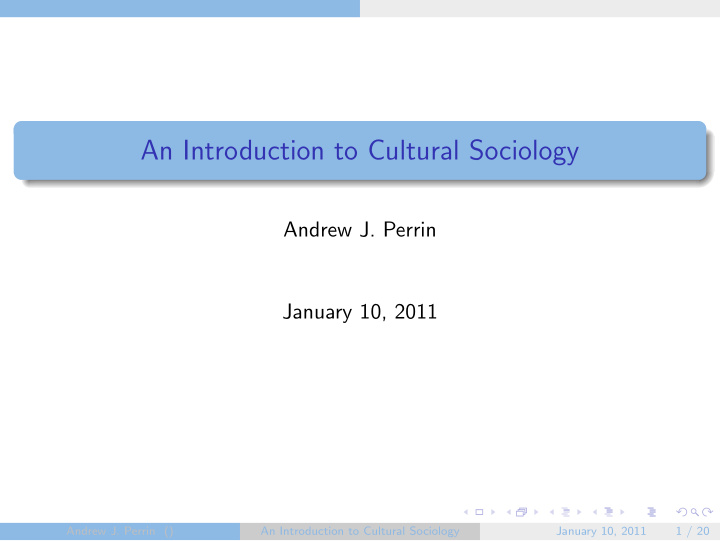



An Introduction to Cultural Sociology Andrew J. Perrin January 10, 2011 Andrew J. Perrin () An Introduction to Cultural Sociology January 10, 2011 1 / 20
Plan for Today’s Class 1 Introduction to Cultural Sociology 2 Prelude to the class 3 Nutritive break 4 Introductions 5 Discussion of lecture and readings 6 Syllabus, course mechanics, and presentation sign-up Andrew J. Perrin () An Introduction to Cultural Sociology January 10, 2011 2 / 20
What Do We Mean When We Say “Culture”? Biological metaphor Andrew J. Perrin () An Introduction to Cultural Sociology January 10, 2011 3 / 20
What Do We Mean When We Say “Culture”? Biological metaphor Andrew J. Perrin () An Introduction to Cultural Sociology January 10, 2011 4 / 20
What Do We Mean When We Say “Culture”? National culture Andrew J. Perrin () An Introduction to Cultural Sociology January 10, 2011 5 / 20
What Do We Mean When We Say “Culture”? High culture Andrew J. Perrin () An Introduction to Cultural Sociology January 10, 2011 6 / 20
What Do We Mean When We Say “Culture”? “Primitive” culture Andrew J. Perrin () An Introduction to Cultural Sociology January 10, 2011 7 / 20
What Do We Mean When We Say “Culture”? Multiculturalism Andrew J. Perrin () An Introduction to Cultural Sociology January 10, 2011 8 / 20
Classical Theorists on Culture ´ Emile Durkheim There is indeed one area in which the common consciousness has grown stronger, becoming more clearly delineated: in its view of the individual. As all the other beliefs and practices assume less and less religious a character, the individual becomes the object of a sort of religion. We carry on the worship of the dignity of the human person.. . . it is a common faith.. . . It is indeed from society that it draws all this strength. The Division of Labor in Society , p. 122 Andrew J. Perrin () An Introduction to Cultural Sociology January 10, 2011 9 / 20
Classical Theorists on Culture Durkheim and Mauss Durkheim & Mauss, Primitive Classification . . . Durkheim, Elementary Forms of Religious Life Andrew J. Perrin () An Introduction to Cultural Sociology January 10, 2011 10 / 20
Classical Theorists on Culture Weber . . . very frequently the ‘world images’ that have been created by ‘ideas’ have, like switchmen, determined the tracks along which action has been pushed by the dynamic of interest. ‘From what’ and ‘for what’ one wished to be redeemed and, let us not forget, ‘could be’ redeemed, depended upon one’s image of the world. Tastes and consumption Status groups Religion Andrew J. Perrin () An Introduction to Cultural Sociology January 10, 2011 11 / 20
Classical Theorists on Culture And yes, even Marx! What, then, is the cost of production of labour power? It is the cost required for maintaining the worker as a worker and of developing him into a worker. Andrew J. Perrin () An Introduction to Cultural Sociology January 10, 2011 12 / 20
Early American Sociology of Culture Talcott Parsons Remember the AGIL paradigm The cultural system was one piece of the social system Functions of the cultural system: social values and norms Culture was considered constant, relatively static, and external to actors Andrew J. Perrin () An Introduction to Cultural Sociology January 10, 2011 13 / 20
After Parsons: Clifford Geertz Thick description Interpretive approach to culture The meaning of a wink Andrew J. Perrin () An Introduction to Cultural Sociology January 10, 2011 14 / 20
Anthropological Approaches to Culture A Caricature! Culture inheres in discrete, definable groups These groups are authentic and relatively static Close observation can reveal underlying cultural realities But. . . Much of this underlies our current thinking about culture Andrew J. Perrin () An Introduction to Cultural Sociology January 10, 2011 15 / 20
Mass Culture and Critique Adorno and Horkheimer, “The Culture Industry” In late capitalism, culture is industrialized Massification makes culture easy to consume but fake and predictable Mass culture incorporates its own critiques Note that cultural studies takes its starting point as a critique of this position Andrew J. Perrin () An Introduction to Cultural Sociology January 10, 2011 16 / 20
Stratification of Consumption Bourdieu and his minions Bourdieu, Distinction : taste is a stratified, social characteristic Social class predicts cultural taste, and Cultural taste is used to mark and claim social identity Museums, concerts, art, music tastes, cuisine, etc. Andrew J. Perrin () An Introduction to Cultural Sociology January 10, 2011 17 / 20
Four Current Schools of Culture These are in competition but also often overlap 1 Cultures as clusters of identifiable values (Inglehart) 2 Cultures as repertoires of “styles, skills, and habits” (Swidler) 3 Cultures as autonomous systems of signs and interpretations (Alexander) 4 Cultures as discrete national traits (Lamont) Andrew J. Perrin () An Introduction to Cultural Sociology January 10, 2011 18 / 20
The Culture Section Institutionally, the ASA culture section holds these very distinct groups This somewhat ad-hoc grouping has been productive The course seeks to interrogate the connections and the fissures Join the section! Andrew J. Perrin () An Introduction to Cultural Sociology January 10, 2011 19 / 20
Metaquestions for Cultural Sociologists 1 What unit(s) of analysis have culture? 2 How and where can we “find” (measure) culture? 3 Where does people’s culture(s) “live”? 4 Where (if at all) does culture fit in a causal chain? Andrew J. Perrin () An Introduction to Cultural Sociology January 10, 2011 20 / 20
Recommend
More recommend